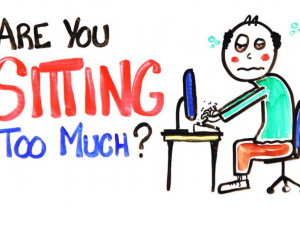Ways to Reduce Pain Naturally
©2018 Health Realizations, Inc. Update
Millions of Americans are impacted by pain in their daily lives. In fact, according to "Health United States," released by the Centers for Disease Control and Prevention's National Center for Health Statistics, one in four Americans have experienced a full day of pain in the last month - and one in 10 said the pain lasted for a year or more!
Another national poll found similar results: more than half of the respondents said they suffer from chronic or recurrent pain, and 46 percent said they had felt pain in the last two weeks.
"Pain has been a hidden disease," says Raymond Gaeta, MD, an associate professor of anesthesia at Stanford University's medical school and director of pain management at Stanford Hospital & Clinic. "It has not received as much attention as other diseases. But now there's a growing recognition that pain really is not just the sensation we have. It's something that interferes with every one of us, with life."
11 Percent of Americans Feel They Have "Hardly Any" Control of Pain
While more than eight out of 10 Americans polled felt they had some control over pain, another 11 percent said they had "hardly any" or "no control at all" over pain.
Among the most common methods used to relieve pain were over-the-counter drugs and prescription drugs, with 84 percent and 60 percent, respectively, of poll respondents trying them at least once. Other common methods were home remedies (81 percent), bed rest (58 percent) and prayer (58 percent).
How to Relieve Pain Naturally
Fortunately, whether your pain is in your back, knees, hands or head, and whether you know the cause or not, there are natural methods that can help steer you toward a more pain-free life.
"Alternative therapies often help," says Ronald V. Myers, M.D., president of the American Pain Institute. "I think it's important for both physicians and the public to keep an open mind. I support whatever works." Here are six natural, alternative therapies to consider:
- Listening to Music
A study of 40 Ohio pain-clinic patients found that those who listened to music (ranging from pop to jazz to nature sounds) for an hour a day reported a 12 percent to 21 percent reduction in pain. Music has also been used to effectively reduce labor pain, post-surgery pain, and burn treatment.
- Chaste Tree Berry for PMS-Related Pain
A study in the British Medical Journal reported that women who took an extract of chaste tree berry for three consecutive menstrual cycles had a 52 percent reduction in PMS symptoms compared with only a 24 percent reduction for those taking a placebo. Among the symptoms relieved were breast tenderness, headache and irritability.
- I
ncrease Your Omega-3 Intake
Inflammation causes the pain associated with arthritis, multiple sclerosis and many other conditions. By avoiding processed foods, food with a lot of salt, fat and sugar, and trans fats, inflammation can be greatly reduced.
Also important is avoiding an excess of omega-6 fats (from corn oil, sunflower oil, and other vegetable oils), and eating plenty of anti-inflammatory foods, like fruits and vegetables.
Along with avoiding the "bad" fats (trans fats and too many omega-6 fats), experts say eating plenty of good fats, like the omega-3 found in cold-water fish and fish oil, is essential.
"Changing the kinds of fat in your diet plays a big role in decreasing or increasing inflammatory hormones," said dietitian Marla Brodsky, RD, LD. In fact, researchers in Cincinnati found that women who took fish-oil pills for two months had significantly reduced pain from severe cramps, compared to women who took a placebo.
- Consider Getting a Pet
Having a pet has been found to lessen stress, provide a better quality of life for those with orthopedic disorders and contribute to better overall health.
And while visiting a friend's pet may have some benefit, said Mara Baun, D.N.Sc., professor at The University of Texas School of Nursing at Houston, "People derive the greatest health benefits from their own pet, or one to whom they feel some personal attachment."
- Yoga
A study by researchers at UCLA found that yoga is also an effective tool to relieve chronic pain from migraines, osteoarthritis and more.
"People suffering from chronic pain go through more than just the pain itself," said Sonia D. Gaur of Harbor-UCLA Medical Center's department of psychology. "They contend with anxiety and depression as well as medication usage. Our study found improvement in every area."
In the study, 18 people with chronic pain participated in 90-minute yoga sessions three times a week for four weeks. Most of the volunteers experienced pain reduction that was significant enough for them to "ask their physicians to decrease their medication."
"Some people live with chronic pain their whole lives," Gaur says. "Yoga is another way of coping with these ailments."
- Hypnosis
A 2000 meta-analysis of 18 published studies found that 75 percent of study participants experienced "substantial pain relief from hypnotic techniques," according to the American Psychological Association (APA).
The psychologists who performed the meta-analysis reported that "hypnotic strategies are equivalent or more effective than other treatments for both acute and chronic pain, and they are likely to save both money and time for patients and clinicians."
"Evidence suggests that hypnosis might be considered a standard of treatment unless the person fails to respond to it or shows a strong opposition against it," according to the APA.
For the majority of Americans, pain - either chronic or the kind that comes and goes - is a way of life. More than half of us suffer from physical pain, which means that if you were to stop someone randomly on the street and ask "Are you in pain?" chances are high that they'd say yes.
This finding comes from a nationwide phone survey of over 1,200 Americans, sponsored by Stanford University Medical Center, ABC News and USA Today. Back pain was the most common type of pain reported, followed by knee and shoulder pain, joint pain and headaches.
7.
Deep and Proper Sleeping/Relaxation
Says Dr. Neil B. Kavey, director of the Sleep Disorders Center at Columbia-Presbyterian Medical Center in New York City, sleep is the time when your body is able to do repair work. So whether you're in pain from an injury or due to an underlying condition, your body will be able to fight and work toward healing that pain while you sleep.
Pain and sleep is a bit of a catch-22 though, in that often people with pain have trouble falling asleep. If this sounds familiar to you, you may want to try sleep meditations as noted above and as follows.
Relaxation is important, not only in helping you to fall asleep, but by reducing tension in your muscles, which can help to relieve pain or keep it from getting worse. Being relaxed may also help any other pain relief methods you're using to work better. Mentally find ways to give your body "permission" to relax, calm your mind, soothe your emotions and create a state of deep relaxation in your body.
8. Prayer/Meditation
Meditation and prayer are ways to calm your body, focus your mind and reduce stress, all of which can help to lessen your feelings of pain. Prayer is the most commonly practiced type of meditation, and according to the first study it ranked right up there with prescription drugs for its ability to relieve pain - and for some can be done without any of the possible negative side effects of drugs.
"Prayer falls in the category of having patients learn about the meaning of their pain. Sometimes patients do need to be introspective before they can move forward," said Gaeta.Meditation includes concentration meditations, in which you focus your mind on a single object, phrase or thought and often practice deep breathing as well, and exercise meditations like yoga, tai chi and qi gong. Even reading, thinking about those you love and writing can be forms of meditation. Pick the method that feels most naturally alluring to you.
9.
Stretching
After three weeks of stretching, stretching Jacques Gauthier who has become a renowned stretching expert was able to reduce his pain by 50 percent. Stretching helps to reduce tension in your muscles, improve flexibility and range of motion, and may slow the degeneration of your joints. The act of stretching alone will also improve your blood circulation and help you to relax-a key to pain relief.
10. Reduce/Prevent Inflammation
When your body is in a chronic state of inflammation, the inflammation can lodge in your muscles, joints and tissues. Over time, this can lead to physical pain, as well as a number of diseases including heart disease. Emotions (too much stress), diet and lifestyle all contribute to inflammation.
One of the safest, low-risk things you can do to lower your risk of inflammation is to modify your lifestyle and dietary choices. This means eating a variety of anti-inflammatory foods (fruits and vegetables), limiting or avoiding all together the pro-inflammatory foods (highly processed foods, high-sugar foods, trans fats, etc.), exercising and quitting smoking (if you do).
11. Regular Exercise
"One of the most important aspects of managing one's pain is taking an active role in care and becoming part of the treatment team," says Penney Cowan, executive director of the American Chronic Pain Association. "There are many treatment options available to help people reduce the effects of pain in their lives. Proactive behavior such as recognizing emotions and practicing relaxation techniques to reduce stress, pacing activities and working within personal limits, and exercising on a regular basis may contribute to better pain control."
Although you may be tempted to not move around much when you're facing pain, a regular exercise program can actually help to relieve pain. According to the Mayo clinic, exercise works by prompting your body to release chemicals called endorphins that actually block pain signals from reaching your brain.
"Endorphins are the body's natural pain-relieving chemicals that in many cases are more powerful than morphine," says Edward Laskowski, M.D., a physical medicine and rehabilitation specialist and co-director of the Sports Medicine Center at Mayo Clinic, Rochester, Minn.
Plus, exercise will help you to sleep better, have more energy to cope with your pain, and lose weight, which will relieve any excess strain on your joints. If you're currently in pain, remember to consult your physician before starting any exercise program.
12. Hot or Cold Packs
Applying a hot pad or cold pack to your area of pain can provide temporary relief. Hot pads are helpful for sore muscles, while cold packs work by numbing the affected area. If you've only tried one or the other, switch to the opposite and see if it works. Be careful not to use a pad that is too hot or too cold, and when using a cold pack, wrap it in a towel so you don't expose your skin to the cold.
Sources
National Center for Health Statistics
CNN.com
ABC7Chicaqo.com
FOXNews.com
MedicineNet.com
American Psychological Association
Medical News Today
The Mayo Clinic






